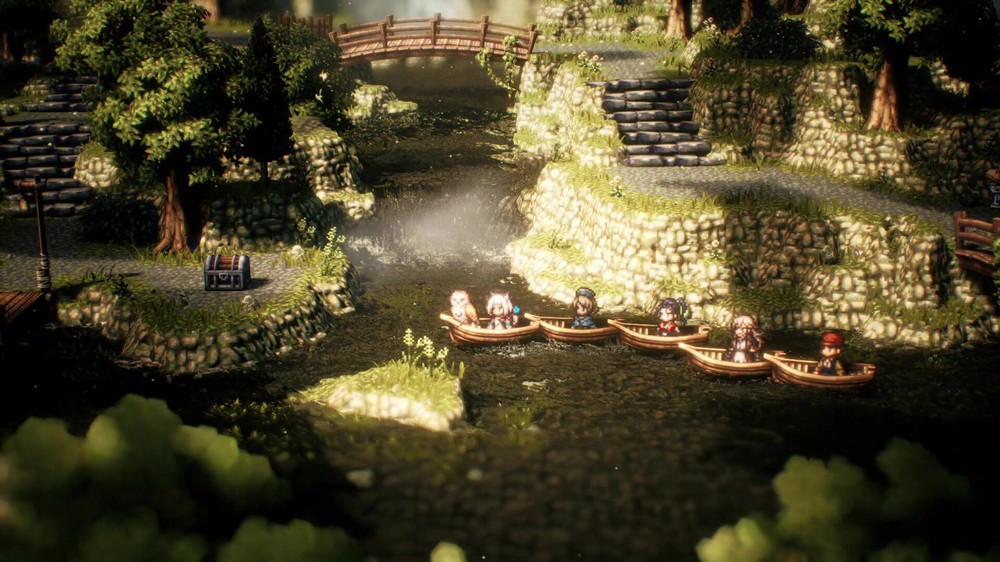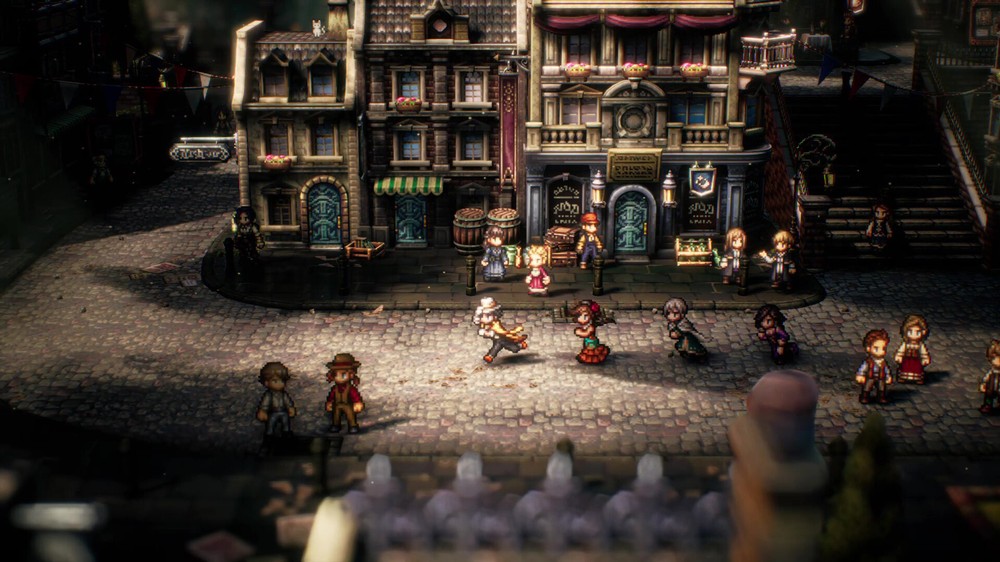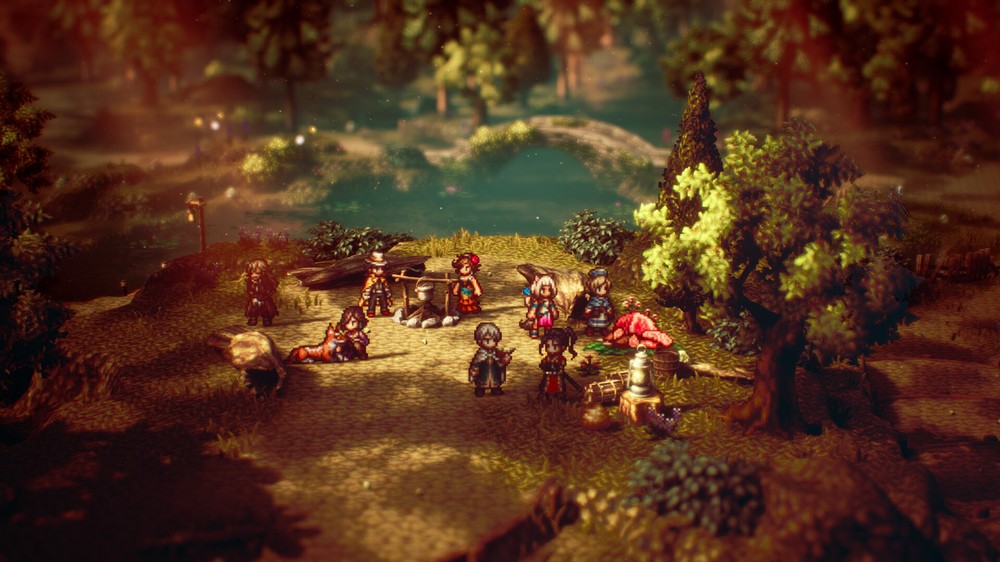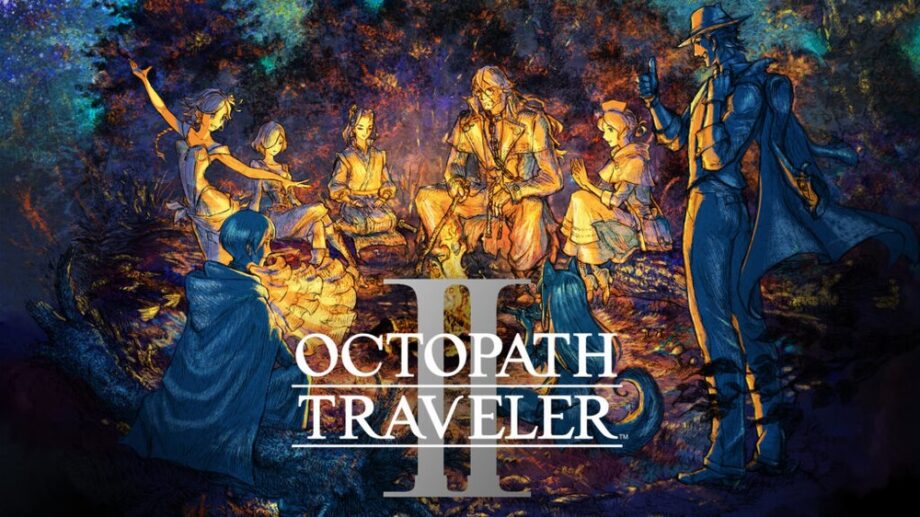When Octopath Traveler was released in 2018, players flocked to it for its fantastic narrative and undying loyalty to the old JRPG standards. It did come with a bit of a learning curve and had a few flaws with it. However, Square Enix and Acquire learned from those flaws and have made several improvements to the old formula with Octopath Traveler II. The writing is done masterfully not just in main quests, but in the NPCs and side quests. Even how players transition through each chapter of the characters is done as if the developers have mastered their craft. The fighting system has been tweaked to make fighting smooth and enjoyable. Even the graphics and soundtracks are stunning and blissful. Octopath Traveler II does the impossible and makes the sequel more appealing than the original.
Storytelling is undoubtedly the most important feature of Octopath Traveler II. It’s difficult to fully express how beautifully it is written because of the varying levels it can resonate with players. Many NPCs are given description paragraphs, which make it clear in the short form. These sections are always fascinating to read since they sum up the history of the characters in a few funny, uplifting, sad, or even spooky phrases. The conversation between party members during travel, which frequently occurs in tiny scripted events, provides a stronger example. Although most tale chapters in Octopath treat the chapter’s main character as if they were on their own, even if these sadly only happen between the four members of the active party, they are great opportunities to observe party members connect before the final chapter. The stories told in the individual character chapters are especially deserving of praise. All of them are superbly written, and they range from ones that show players’ happy personal development to ones that will make them recoil in horror at the depravity that evil can inflict upon the most helpless. Any game would be fortunate to have one of these central plots serve as its major narrative, but Octopath Traveler II generously provides eight for players to enjoy.
 Crossed Pathways are brand-new tale chapters in Octopath Traveler II that don’t have such a narrow emphasis. In them, characters are paired up and work together to tackle local issues. The eight tourists genuinely act like friends as the pairs talk nonstop while telling quick five- to fifteen-minute anecdotes. In Octopath Traveler II, there are obvious big-picture events taking place in the country of Solistia, as opposed to the hazy hints dropped along the way and played out in side-quests in the first entry. These events come to a head in a final chapter that becomes clearly signposted and available once the eight travelers’ stories are all finished. In this last chapter, the characters interact quite a bit and in satisfying ways. But reservations about the sequel’s radically divergent plot aren’t entirely allayed, having a satisfying overarching narrative with a satisfying conclusion is a significant improvement over the original game. The incredible variety in scale and storytelling overall results in a beautifully polished narrative experience.
Crossed Pathways are brand-new tale chapters in Octopath Traveler II that don’t have such a narrow emphasis. In them, characters are paired up and work together to tackle local issues. The eight tourists genuinely act like friends as the pairs talk nonstop while telling quick five- to fifteen-minute anecdotes. In Octopath Traveler II, there are obvious big-picture events taking place in the country of Solistia, as opposed to the hazy hints dropped along the way and played out in side-quests in the first entry. These events come to a head in a final chapter that becomes clearly signposted and available once the eight travelers’ stories are all finished. In this last chapter, the characters interact quite a bit and in satisfying ways. But reservations about the sequel’s radically divergent plot aren’t entirely allayed, having a satisfying overarching narrative with a satisfying conclusion is a significant improvement over the original game. The incredible variety in scale and storytelling overall results in a beautifully polished narrative experience.
The map of the game clearly shows players where they must go in order to start the next chapter of each character’s story, along with a suggested party level, thanks to the chapter system. It’s a welcome departure from the previous game that not every proposed level is present in the second and third chapters. Instead, they are spaced out to provide a smoother route for less experienced players, minimizing the need for extended periods of intense grinding to advance the story. Nonetheless, depending on the party and skill configuration, a number of the monsters in each chapter can prove to be challenging challenges for even parties that are typically five to ten levels over the recommended level. In the same vein, under-leveled teams may have great success if they dive deep and find their own game-changing combinations.

Since the writing in Octopath Traveler II is so excellent, players might be tempted to cut corners in other visual areas, but there is really no justification for doing so. The game is amazing aesthetically and aurally. All the sprites and stunning backdrops, foregrounds, and midgrounds in the first Octopath Traveler, which introduced gamers to the wonders of HD-2D five years ago, are still compelling enough to keep players from becoming weary of this aesthetic. Everything seems to be rather alive, especially when there is some movement caused by the wind or changing light patterns. In-depth views of each character’s distinctive work uniform may be found throughout the several various fight sequences. Some of these animations could only appear when a single character with a certain job makes use of a certain talent. There is a lot of attention paid to these figures’ motions, and they look wonderful. Despite the game’s stunning visuals, there are a few significant bugs. Similar to the earlier game, the monster designs rely too heavily on various iterations of the same creature engaging in simultaneous combat.
The fighting system in Octopath Traveler II meets the high standards set by the narrative and graphic design, and most turn-based aficionados will adore it. The fighting system builds on the foundation of the original game and provides players full control over each character while fitting a lot of information onto the battle screen. The turn order is clearly shown at the top of the screen, and before deciding to proceed, one may modify it by switching between assaults and talents in the menu. An emblem of such kind will remain on the screen each time a player faces an enemy if they discover the ideal weapon or element to use to attack them. Opponents have shields that can be shattered with enough of the appropriate attacks. Breaking enemy shields not only stops enemies from attacking that round and the next, but it also increases damage dealt to enemies while they are stunned. The Octopath fighting system splits its time between strengthening one’s own characters and dismantling the enemy’s defenses. At each round, characters are awarded Boost Points (BP). A character may utilize up to three of them throughout their turn to boost their attack, skill, or spell power. Five of these can be banked by each player, however, some of the most powerful abilities and spells need full BP consumption.

Each character in the game begins locked into a certain job class, but they can change their subclass to access another job and both skill pools while battling. Each fight rewards Job Points (JP), which may be used to purchase the eight battle talents unique to each job, in addition to gold and experience points. The usage of these passive support abilities will then provide passive benefits including improved stats, post-battle prizes, different immunities, and other abilities. Each of these lets players thoroughly and amusingly alter characters to accommodate various play preferences. On top of each unique set of job abilities, every character has a unique latent ability that is based on their original class and is unique to them. These powers are controlled by a meter that, when filled, unleashes catastrophic attacks or grants tremendous benefits. The meter fills up throughout combat as a result of dealing or absorbing damage. They have the capacity to drastically change a war’s trajectory when deployed wisely. The few enhancements it makes to the excellent battle system from the original game set the bar even higher.
Octopath Traveler II provides players with additional actions when they want a break from combat or to progress the plot. Every playable character has two path actions that they can use on the majority of NPCs. There are several ways to learn about NPCs, acquire any items they may be carrying, knock them out, or temporarily add them to the party. Each of the actions are utilized based on the time of day, which can be changed easily. The majority of quests can be started by speaking to a single NPC, but they must be completed by traveling and using characters’ path actions throughout the world to get additional information. In order to acquire their characters’ ultimate job skills, secret job classes, and even opportunities to acquire additional licenses so that multiple characters can subclass to the same job, players can also look for shrines that may be hidden away in difficult-to-see locations or occasionally right there in plain sight. Several of the jobs involve completing tasks in order to obtain licenses or develop one’s skill set. The most rewarding side-quests even connect job requirements with side-quests, employing numerous gaming actions to finish a single interconnected goal. These interactions provide incredible new options for world-building.

Octopath Traveler II does something most sequels cannot do and that is being better than the original. The storytelling is captivating and continued to draw me in with each new detail. The side-quests add a nice dash of exploration and make players utilize each available job to complete each one. The characters and their jobs are fantastic and add tons of replayability for those who want to try out different starting points. The fighting system is one of the best turn-based ones we have seen in a long time. Even the side quests were carefully developed with players utilizing character job actions to progress with each one. Overall, I would highly recommend grabbing a copy if you are a fan of JRPGs and are looking for something to entertain you for a good while.











